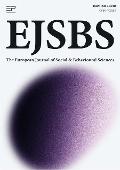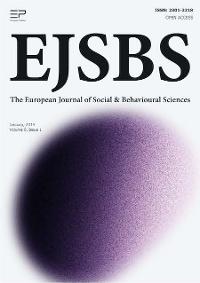Abstract
This article describes methods and results of study of personal features and research potential of Russian students. We revealed differences in these characteristics in 245 students of different years and fields of education. We found out differences in levels of research potential development between bachelor students, master students and specialist students of humanities and natural sciences. We defined and described those personal features which promote active students’ involvement in research and hence - research potential realization, independently of university and educational field. We characterized personal features of students with high level of research potential. Obtained results are a psychological basis for masters’ instruction differentiation, scientific supervision style selection and psychological support of students’ individual learning and scientific work organization.
Keywords: Students, personal features, research potential
Introduction
Why do we study personal features of students involved in scientific work during learning and preparation for future professional work? Firstly, research activity was and still is a major part of higher education. Students’ involvement in scientific search and experimentation is one of main conditions of better quality of today's professionals and realization of students’ personal potential Bordovskaia (2013). Secondly, student’s scientific research has a peculiar qualitative nature (tempo, rhythm), determined by person’s properties as its subject Abuljhanova (1991). Thirdly, it is seen from study of personal features of scientists Cattell (1963). that ability to research more due to personality and its values, not intellect.
Research Questions
Are there differences between students of different universities and educational fields in level of research potential development? What students’ personal features promote success of their research activity and research potential realization?
Purpose of the Study
The aim of this research is to:
- Define research potential level of students of different universities, educational levels and fields;
- Study personal features of students which interrelate with effective research potential realization in learning.
We understand research potential as an integrative characteristic of a person’s abilities which ensures achievement of personally important and socially significant aims in the field of scientific research in the past, present and future Bordovskaia (2012).
Phenomenology of research potential (RP) has following specific features:
1.Research potential has systemic features and cannot be cut down to a simple list of researcher’s personal qualities.
2.Research potential is characterized by latent features, which may reveal themselves with the change of certain conditions.
3.Research potential features determine the developmental opportunities of a person as a researcher both in the nearest future and in the remote perspective.
4.Research potential is introduced here to analyze the special features of psychic regulation of research process.
Three main components of research activity (motivational, reflexive/cognitive and behavioral/performance) correspond to certain components of RP:
- Motivational component of a person’s research potential reveals itself in inquisitiveness and interest to research, in enjoying getting new knowledge, in personal value of scientific knowledge;
- Cognitive component of research potential reveals itself in feeling of a lack of knowledge about a particular object or phenomenon, a lack of understanding of something, being sensitive to contradictions, originality and productiveness of thinking, in the skill of putting clear questions and formulating persuasive suggestions, in the aptitude to get a clear picture of all the details of a situation simultaneously;
- Behavioral component of research potential reveals itself in desire to meet the demand in knowledge by action, in the balance between clear and unclear algorithms of researcher’s behavior, in the persistence and stamina in search for new knowledge and in acquisition of new skills during research practice.
Study included an analysis of personal features of students that have different level of research potential and different educational levels and fields.
Research Methods
Participants
Study involved 290 people. 45 of them were SPSU teachers (mean age 41,8±11,6 years), who participated in program of professional development “Teacher of higher school”. 245 of them were students (mean age 22,3±1,4 years) of Saint Petersburg State University: departments of psychology (23), history (17), medicine (31), economics (79); Herzen State Pedagogical University: psycho-pedagogical department (53); Novgorod State Pedagogical University: departments of: natural sciences (25) and mathematics (17). Educational level: 79 bachelor students (31,9%), 93 master students (38,8%), 73 specialist students (29,8%).
Instruments
1. To study students’ personal features we used: Five-factor personality inventory (Costa and McCrae) Khromov (2000); Kirton’s inventory Kirton (1976); Peysakhov’s Self-organization inventory Ishkov (2004); Zimbardo’s time perspective inventory Mitina and Syrtsova (1996), Panteleev’s self-attitude inventory Posokhova and Solovyeva (2008).
2. Method of study students’ research potential was developed by a group of psychologists and pedagogues at St. Petersburg State University Bordovskaia, Kostromina, Moskvicheva, & Rosum, 2012). This method includes 51 questions for estimating motivational, cognitive and behavioral components of research potential, 30% of the questions are of the opposite character, 10-point-scale assessment for each indicator (10 points – the highest). The total score is the sum of assessments for all 51 indicators. We consider three levels of research potential: high, medium, low.
3. To obtain data about research potential realization we used a questionnaire taking into account number of publications, participation in conferences and research projects.
To process the empirical data we used methods of Kolmogorov-Smirnov, Kruskal-Wallis and Mann-Whitney.
Procedure
All inventories were put together in one package to fill. Package included general questions (sex, age, education, research activity and publications) and instructions with reply form for each task. Offered material totally made 5 pages, filling time varied from 45 minutes to 1 hour. Inventories have been filling individually and on paper. In the beginning the researcher explained the procedure to participants and asked possible questions. Instructing during the filling was not allowed. After the procedure filled package processed. Results were brought to participants in 7-10 days – they showed great interest in study data.
Processing was carried out in accordance with scales indicated in inventories. Total number of scales was 48: 4 scales of research potential inventory; 5 scales (each with 5 sub-scales) of Five-factor personality inventory; 1 indicator of Kirton’s and 1 of Karpov’s; 8 scales of Peysakhov’s inventory; 6 scales of Zimbardo’s and 9 scales of Panteleev’s self-attitude inventory.
Used scales is directed to assess personal features of students with different levels of research potential in attitude to time, attachment-autonomy, control-spontaneity, extraversion-introversion, emotionality-restraint, romanticism-practicality, innovativeness-adaptation, curiosity, intolerance to novelty, reflexivity, self- confidence, self-worth, self-acceptance, self-leadership, self-organization.
Findings
Study results given in the following order: First – we compared levels of research potential development in students of different educational levels and fields. Also we collated obtained results with data on teachers of higher school. Second – we revealed and described personal features of students with high level of research potential. Third – we revealed interrelation between psychological students’ features and level of their research potential. In our opinion, such results assessment allowed us to reveal personal students’ features, necessary to solve research problems.
Assessment of research potential level in interrelation with educational level
Educational level supposes student’s readiness to solve research problems of different kind. Education of future bachelors is mostly theoretical. Its aim is general training in certain field of education (humanities, technical, natural sciences). Students perform mini research works, get involved in search for scientific information, analysis, synthesis and comparison of results on a particular subject. In magistracy, proportion of research activity increases. Students are included in research projects, they develop and implement research work design, choose and use methods to solve research problems, confirm their results using methods of Statistics. Work of university teacher directly related to research projects: when supervising students’ work and when interacting with colleagues. Efficiency assessment of teacher’s work is constructed including his scientific activity. So, it’s advisable to expect increasing research potential level in transition from bachelor level to magistracy level and further to teaching staff. We assumed that such dynamics reflects nature of research potential development – depending on research problems complexity provided by appropriate educational level and manifesting in “fluidity” of research potential.
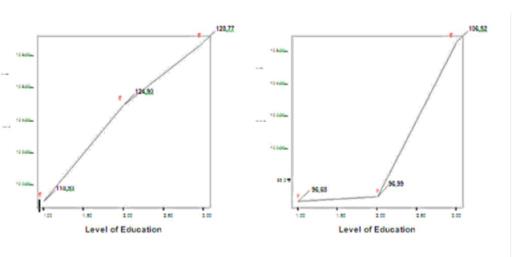
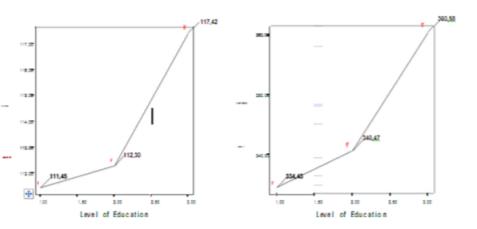
We analyzed study results both in general level and in expression of each component of research potential. On Figure 1 and 2 we presented changes of motivational, cognitive, behavioral components and total score of research potential in participants of different educational levels. We obtained significant differences in cognitive component between groups of bachelor students (р=0.0001), master students (р=0.0001) and group of teachers; in motivational component between groups of bachelor students (р=0.0001), master students (р=0.0001) and group of teachers; in behavioral component between groups of bachelor students and groups of master students (р=0.0001) and teachers (р=0.0001). In total score of research potential we obtained significant differences from group of bachelor students to group of master students (p=0.064) and from group of master students to group of teachers (р=0.0001).
Despite the fact that for total score of research potential it’s typical to increase depending on educational level and hence – research tasks complexity, analysis of each component does not give such a clear result.
Differences in research potential between students of different educational fields
We obtained following results of research potential total score in students of different educational fields: department of economics (M±SD 325.7±50,2), psycho-pedagogical department (M±SD 349.8±39.07), department of natural sciences and geography (M±SD 321.0±52.2), department of physics and mathematics (M±SD 331.3±43.2), psychology department (M±SD 377.4±28.7), history department (M±SD 294.2±21,46). We found significant differences (Mann – Whitney criterion) between students of department of physics and mathematics and psycho-pedagogical department (p<0.016), psychology department and department of physics and mathematics, and also department of natural sciences and geography (p<0.001), history students and all other students (from p<0.013 to p<0.001).
We obtained significant differences in expression of each component of research potential in students of different departments (Mann – Whitney criterion): motivational component – between psychology department and all other departments (from p<0.019 to p<0.01); cognitive component – between psycho-pedagogical department and department of natural sciences (p<0.009), department of mathematics and department of economics (p<0.039); behavioral component – between psycho-pedagogical department and department of mathematics, and also department of natural sciences (p<0.01, p<0.006 respectively); between department of mathematics and department of economics (p<0.026), between department of natural sciences and department of economics (p<0.026), between psychology department and all other departments (from p<0.05 to p<0.01).
Motivational and behavioral components expressed most in psychology students (M±SD 116. 5±10.18for motivational and M±SD 130.5±10.06 for behavioral components). Cognitive component of research potential expressed most in students of psycho-pedagogical department (M±SD 133.9±16.14). Obtained results undoubtedly reflect role of educational field in research potential development and realization. So, the lowest rates were obtained in departments of economics and history which show practical focus and prevalence of practice-oriented lessons to develop skills for solving real problems in practical activity. On the other side, the highest rates in development of research potential components were obtained in future pedagogues and psychologists. Their professional training connected with understanding and researching human behaviour, his development and education. It stimulates students to active research.
Personal features of students with different levels of research potential
In our study we consider that successful research activity depends on subject’s personal qualities and at the same time – it is an environment of these qualities development. Knowledge and skills of research can be acquired in learning, but interest in research activity, its value to person depends only on features of personality structure. So, students’ research activity has different forms, intensity and efficiency. To confirm this fact, we analyze personal features of students and teachers with different levels of motivational, cognitive and behavioral research potential components.
Pairwise comparison of groups of bachelors, masters and teachers revealed differences presented on Figure 3 and 4.
Obtained results indicate that characteristic “intolerance of ambiguity” shows no significant differences between bachelors and masters. However, there are significant differences between bachelors and teachers and also between masters and teachers. Higher rates of this characteristic in teachers probably suggest that experience of scientific activity leads to ability to perceive the scientific uncertainty as a challenge that requires an answer in form of problem solving, finding ways solutions in new, unstructured, changing situations.
“Curiosity” increases linearly in rates (р<0.05) from bachelors’ level to magistracy level and then to teachers’ level (Figure 3).
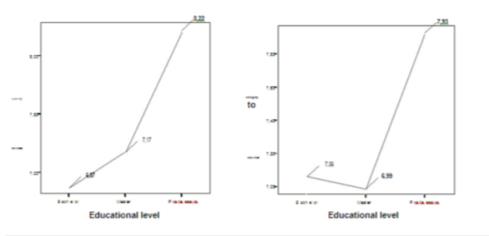
Perhaps accumulation of scientific knowledge and experience of research lead to greater tendency in searching new scientific information and motivate to expand scientific borders. Or conversely, that person becomes a teacher if it has a desire to research. The highest level of intolerance to novelty rate achieved in masters (р<0.05), decreases in teachers and even lower rates (р<0.05) are in bachelors. In other words, willingness to experiment and use new and unknown ways of solving problems is most express ed at masters’ level. Perhaps experience in scientific activity has a nonlinear effect on expression of this rate.
Pairwise comparison showed differences between groups in rates of self-organization and self-control: level of self-organization is the highest in higher school teachers and at bachelors’ level, decreasing at masters’ level (р≤0.01) (Figure 4). Probably, experience of research obtained during masters’ level, complexity of scientific problems increases with a simultaneous change of supervisor’s involvement in academic work, delayed scientific result lead to decrease in self-organization of scientific activity. However, this fact requires further research. Rates of self-control increase according with educational level. Leap in its development comes to magistracy time.
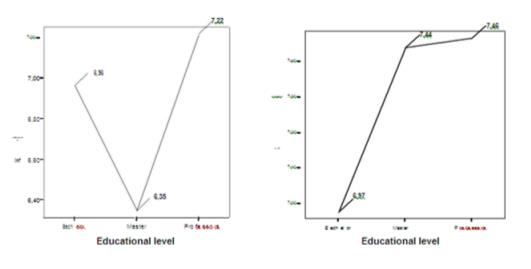
Comparison of personal features of students with high, medium and low research potential level revealed features inherent to students, included in research (table 1). Table shows only parameters that have significant differences when comparing with personal features of students with low level of research potential.
Results suggest that students with high level of research potential are more active, focused on cooperation, persistent in achieving purposes, responsible, curious. They are more artistic and relaxed in behaviour. Their psychological attitude to time: focus on future, desire to consider possible consequences of their actions and potential results of today's decisions. They do not accept present as something beyond their control. They believe that they control life and can change it and reality around. Such attitude to present and future allows them to implement constructive actions, efficiently adapting to environment and circumstances.
Generalization of personal features of students with high level of research potential revealed “Self-Control / Impulsivity” (III factor of Five-factor) and “Expressivity / Practicality” (V factor) to be the most significant factors. More than half of indicators for these factors found significant differences in students with high and low level of research potential. This tendency manifested also in results of correlation analysis. We found positive interrelations between high level of research potential and high level of activity (r= 0.439, p=0.000), self-control (r= 0.512, p=0.001), persistence (r= 0.720, p=0.000) and responsibility (r= 0.583, p=0.000). We can add that students with higher ranks in “expressivity” (r= 0.337, p=0.034), “curiosity” (r= 0.319, p=0.045) and “artistry” (r= 0.352, p=0.026) are more likely to be included in research. This fact is determined by desire of expressive people to show interest to different sides of life, everything new and unusual. We found positive interrelations between levels of self-attitude and research potential. The higher are ranks of self-confidence (r= 0.659 p=0.000), self-leadership level (r= 0.0.636, p=0.000) and self-worth (r= 0.425, p=0.006), the higher is total score of research potential. Interrelations between time perspective and research potential level have their own features. So, students with installations on negative past (r= -0.350, p=0.027), fatalistic (r= -0.461, p=0.003) and hedonistic (r= -0.344, p=0.03) present show less interest to research activity, they are less likely to solve research problems. At the same time, focus on future has direct correlation (r= 0.444, p=0.004) with research potential level.
Conclusions
Revealed differences in research potential development according to educational levels and fields, confirms our assumption about role of subject area in developing students’ research interest. Higher ranks of cognitive component development in bachelors than in masters may indicate a lack of masters’ intellectual preparedness to research activity. At the same time, students who continue education in magistracy are more motivated to research work. But they have less intellectual resource. In developing of behavioral component we observe decreasing of this indicator in teachers. This result may be due to fact that research activity is important but optional part of teacher’s professional activity. So, teachers’ involvement in research is more a matter of passion, realization of need for new knowledge rather than consistent implementation in research procedures and ability to complete tasks. Confirmation of this fact is in the highest ranks of teachers’ motivational component development in comparison with other participants. It is important to note, that for students the most significant thing in subjective assessment of own research potential is also desire to research (motivational component). But additionally, they allocate organizational skills as significant ones (behavioral component). Both components focus on students’ personal features (activity, curiosity, persistence, responsibility).
Obtained in the Russian sample result was confirmed by studies in other countries. In Portugal, longitudinal study (Salgueira, Costa, Gonçalves, Magalhães, & Costa, 2012). (N=435, they also use Five-factor inventory NEO – “Big Five”) showed, that students with high scores on entrance exams and higher rates in “openness to experience” and “conscientiousness” are more likely to engage in research activities while studying. As for factors such as extraversion, that according to available literature data there can be traced opposite tendencies. So, in the same study fixed reverse effect: at high rates of factor “extraversion” students are less likely to be included in research.
At the same time, in another study of six hundred students of West Bengal (India) revealed (Halder, Roy, & Chakraborty, 2010) that searching for scientific information, research activity is negatively related to neuroticism and positively - with “extraversion”. Perhaps, ambiguous interrelation of extraversion with research activity is associated with duality of this psychological feature in human activity. On the one hand, a high level of extraversion helps to be open to new experience, to have multidirectional activities, to get information rapidly. On the other hand, it prevents tasks completion, provides impulsive action, high risk-taking behavior. It is worth noting that in our study was not obtained any direct or inverse interrelation between level of extraversion and research poten tial. Real interrelation was obtained only in a single feature included in factor of “extraversion” – activity-passivity. So we can consider, that active students are more likely to be included in research problems solving and have higher level of research potential.
Study of Halder, Roy and Chakraborty (2010) confirms positive interrelation between exploratory behavior and “openness”, “conscientiousness” and “goodwill”. In our work, presence of such a relationship may be confirmed by higher ranks of “cooperation” and “responsibility” in students with high level of research potential. Role of activity and self-organization in students’ academic and research activity shown by Moskvicheva and Mysnik (2011). According to her study, research potential is expressed in greater activity in research and higher academic progress. In student’s need-motivational sphere dominate success motivation and focus on success but not the process of scientific searching or need of searching for the truth. Similarly we observe interrelation of success motivation with students and postgraduates educational and scientific achievements, revealed in study of S.N. Kostromina (2012). It’s found that significant differences between postgraduates who defended (N=75) and did not defend (N=73) their theses are in self-organization features: self-dependence, persistence in achieving purposes and attitude to time (focus on future). And success motivation closely interrelated with learning activity self-organization, allows managing its cognitive, emotional and personal resources. It can be considered as a key element “triggering” when necessary all system of self-processes in achieving academic results (Kostromina & Dvornikova, 2007).
Results of this study lead us to following
- For total score of research potential it’s typical to increase depending on educational level and hence– research tasks complexity.
- In research potential development significant role plays training specifics (integrative at bachelors’ level, social, humanitarian, mathematical, natural science at specialists’ and masters’ level) – due to specific of subject area and intensity, as well as variety of research problems to solve.
- Research potential development and realization are significantly affected by development of such personal features as self-control, persistence, responsibility, and expressivity, curiosity, artistry, self- confidence, level of self-leadership and self-worth.
Study of personal features of students with high research potential level promotes our understanding of psychological basis of students’ involvement in research. In practical terms, it is important for searching the best conditions in stimulating students to research problems solving and research potential realization. We understand that our study has slice and ascertaining character, so we see its future in conducting longitudinal studies aimed at studying student’s personality development in position of researcher in lifelong learning at bachelor level, magistracy and then postgraduate. Problem of particular interest is researcher’s personality development not only in higher school, but also in period of independent research in different environments – in university, at work or in academic institutes and laboratories. We see a continuation of our work also in conducting cross-cultural research connected with comparison of research potential of students from different countries, their scientific achievements and characteristics of personality development.
Acknowledgements
The author(s) declare that there is no conflict of interest.
References
Abuljhanova, K. A. (1991). Life strategy. (In Russian)
Bordovskaia, N. V. (2012). Research potential and its manifestation among university students. Journal of International Scientific Publications: Educational Alternatives, 10(2), 16-25.
Bordovskaia, N. V. (Ed.). (2013). Modern educational technologies. Moscow: Knorus, (In Russian)
Bordovskaia, N. V., Kostromina, S. N., Moskvicheva, N. L., & Rosum, S. I. (2012). Activity approach to the study of research potential of students. International journal of experimental education, 1, 81-88. (In Russian)
Cattell, R. B. (1963). Personality and other motivation of researcher from measurements of contemporaries and from biography. Scientific creativity, 1l9-131.
Halder, S., Roy, A., & Chakraborty, P. K. (2010). The influence of personality traits on information seeking behavior of students. Malaysian Journal of Library & Information Science, 15(1), 41-53.
Ishkov, A. D. (2004). Students learning activity: psychological factors of success: Monograph. Мoscow: АSV.
Khromov, A. B. (2000). Five-factor personality inventory: Teaching manual. Kurgan: Publishing of Kurgan University.
Kirton, M. (1976). Adaptors and innovators: a description and measure. Journal of Applied Psychology, 61(5), 622-629.
Kostromina, S. N. (2012). Psychological Factors of self-organization academic activity of students. Journal of International Scientific Publications: Educational Alternatives, 10(2), 187-196.
Kostromina, S. N., & Dvornikova, T. A. (2007). Learning strategies as a means of organizing students individual work. SPSU herald. Ser. 6: Philosophy. Political science. Sociology. Psychology. Low. International relations, 4, 273-278. (In Russian).
Mitina, O. V., & Syrtsova, A. (1996). Zimbardo’s time perspective inventory: results of Russian version psychometric analyses. Moscow Univ. herald. Ser. 14. Psychology, 2, 8-18. (In Russian)
Moskvicheva, N. L., & Mysnik, L. M. (2011). Motivation for research activity as students see it. Proceedings of the VI All-Russia Scientific and Practical Conference with International Participation “Health – the Basis of Human Potential: Problems and Ways to Solve Them”. Nov. 24–26. St. Petersburg. (In Russian)
Posokhova, C. T., & Solovyeva, C. L. (2008). Handbook of practical psychologist. Мoscow: АSТ: Khranitel. (In Russian)
Salgueira, A., Costa, P., Gonçalves, M., Magalhães, E., & Costa, M. J. (2012). Individual characteristics and student’s engagement in scientific research: a cross-sectional study. BMC Medical Education, 12-95. http://www.biomedcentral.com/1472-6920/12/95.
Copyright information

This work is licensed under a Creative Commons Attribution-NonCommercial-NoDerivatives 4.0 International License.

